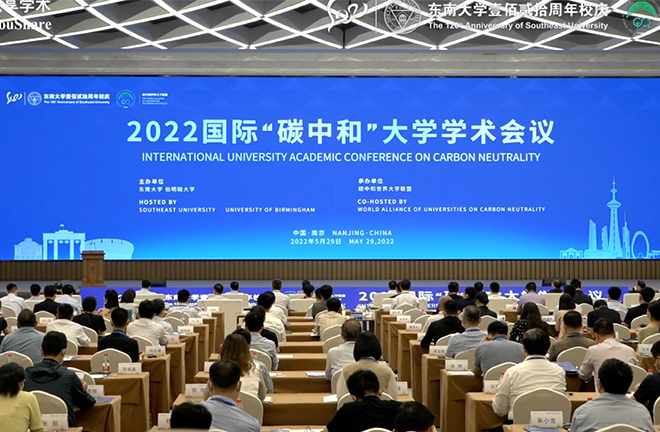Promoting int’l cooperation on carbon neutrality

The International University Academic Conference on Carbon Neutrality (2022) is convened in Nanjing, Jiangsu Province, on May 29. Photo: Wu Nan/CSST
NANJING—Coping with climate change and achieving carbon neutrality is the common cause of all mankind. On May 29, the International University Academic Conference on Carbon Neutrality (2022) was convened, jointly organized by China’s Southeast University and the UK’s University of Birmingham.
Approaches to carbon goals
At present, the global long-term goal of carbon neutrality and global economic and technological changes have been superimposed and evolved, which has profoundly changed global competition and development patterns. China has put forward clear carbon goals. Nigeria, South Africa, and other countries are also promoting relevant agreements.
Scientifically, the United States is moving towards the goal of achieving a zero-carbon economy by 2050 or earlier, and this is what the United States must do, said Nobel Laureate Daniel Kahneman. Achieving this goal requires the continuous promotion and building of partnerships in basic science and politics.
Kahneman proposed that countries around the world should work together to complete large-scale renewable energy application projects and rapidly replace non-renewable energy. We should not only focus on energy subsidy programs, but also reduce the cost of renewable energy through means of capital and technology.
At present, China has successively released implementation plans for carbon peaking and supportive measures in key fields and industries, and gradually built a “1+N” policy framework for carbon peaking and carbon neutrality [“1” refers to China’s long-term approach to combating climate change, well documented in The Working Guidance for Carbon Dioxide Peaking and Carbon Neutrality in Full and Faithful Implementation of the New Development Philosophy, and “N” refers to solutions to achieve peak carbon emissions by 2030, starting with the Action Plan for Carbon Dioxide Peaking Before 2030].
The Action Plan for Carbon Dioxide Peaking Before 2030 was released by China’s State Council in October 2021. It proposed that by 2030, the share of non-fossil energy consumption will reach around 25%, and carbon dioxide emissions per unit of GDP will have dropped by more than 65% compared with the 2005 level, successfully achieving carbon dioxide peaking before 2030.
“Carbon peaking is not about climbing or rushing to a peak, but a decline in total carbon dioxide emissions after reaching the maximum value. It is a turning point, for decoupling continued economic growth from total carbon dioxide emissions,” said Du Xiangwan, former vice president of the Chinese Academy of Engineering. Energy conservation and efficiency improvement are China’s strategic priorities for achieving carbon goals.
Yang Weimin, deputy director of the Economic Affairs Committee of 13th National Committee of the Chinese People’s Political Consultative Conference, said that carbon peaking and carbon neutrality do not mean energy consumption peaking, nor electricity consumption peaking. When the total electricity demand is still in a stage of rapid growth, reduction of coal-fired power should be based on increasing power generation in renewable energy and its consumption capacity, so as to ensure the security of energy supply.
Pan Jiahua, deputy director of the National Committee of Experts on Climate Change, said that the main determinants of greenhouse gas emission reduction include: the development stage, physical space for development, resource endowments, as well as industrial structure and consumer preference, but the most important element is disruptive technology. Although it is possible to achieve low-carbon development by incrementally improving technological progress, it is impossible to achieve “zero-carbon” development without disruptive technological breakthroughs.
“It is necessary to completely eliminate dependence on fossil energy at the level of final consumption demand, and achieve carbon neutrality while ensuring and improving the quality of life,” Pan said.
Roles of universities
According to the Nanjing Declaration of the World Alliance of Universities on Carbon Neutrality, released at the conference, achieving carbon neutrality is an extensive and profound, systematic socioeconomic change. As an important force in promoting human advancement, universities shoulder the historic mission of coping with global challenges and leading development of the times, and should defend, contribute to, and promote global climate governance.
Universities play an important role in achieving carbon neutrality. According to Adam Tickell, vice-chancellor of the University of Birmingham, the university has been committed to developing, applying, and creating various sustainable energy solutions. It is also using new thinking and working modes to achieve technological innovation, such as simulating innovation in clean energy, establishing energy innovation zones, and building an alliance network involving global cooperation.
On the basis of intergovernmental policy dialogue, higher education institutions at home and abroad can innovate the scientific and technological cooperation mode, and carry out international cooperation in the field of low-carbon science and technology at multiple levels and in an all-round way, Du said. It is also advisable to actively carry out international cooperation on low-carbon standards and labels.
Edited by JIANG HONG
